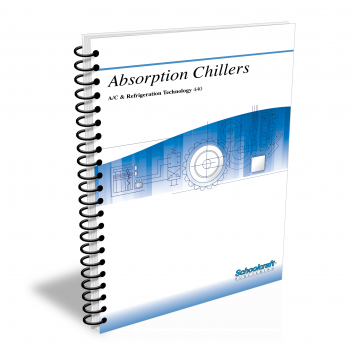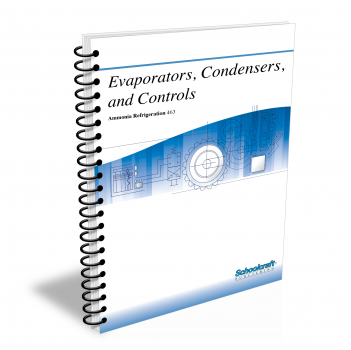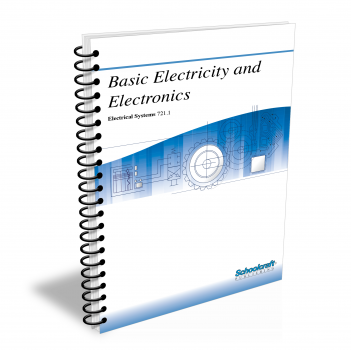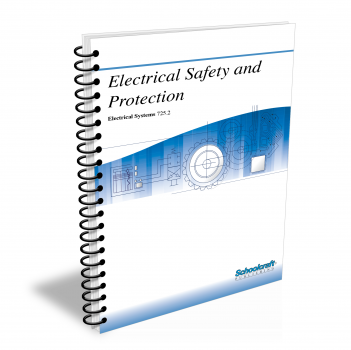Absorption Chillers

Course Number: 440
The Absorption Chillers textbook covers the basic principles of absorption refrigeration as compared to mechanical refrigeration. It introduces absorption terminology and common absorption fluid pairs. It examines water/lithium bromide systems, ammonia/water systems, and evolving systems, and concludes with a discussion of chiller selection factors, cost of operation, and absorption system applications.
Does your curriculum require additional topics not included in this textbook? Build a customized version of the Absorption Chillers textbook below.
Recommended Contact Hours – 12
Preview a Chapter
Available Supporting Material
- Table of Contents
- Exam Copies
- Suggested Titles
Table of Contents
Table of Contents
Chapter 1: Principles of Absorption Chiller Systems
Topics: Mechanical vs. absorption refrigeration systems; Absorption terminology; Single-effect absorption cooling; Common absorption fluid pairs
Learning Objectives:
- Explain the differences between a mechanical refrigeration system and an absorption system.
- Describe the basic components in a simple absorption system and their functions in the refrigeration cycle.
- Distinguish between the characteristics of a weak solution and a strong solution and explain the function of each in the absorption cycle.
- Define the terminology associated with absorption systems.
- Describe the steps in a simple single-effect absorption cooling cycle.
Chapter 2: Water/Lithium Bromide Absorption Systems
Topics: Water/lithium bromide systems; Double-effect direct-fired system; Solution flow cycles; Operating characteristics; Crystallization
Learning Objectives:
- Discuss basic characteristics of water/lithium bromide absorption systems and name common industrial uses.
- Describe the differences between single-effect and double-effect absorption systems.
- Discuss the action of the solution and the refrigerant throughout a solution cycle within absorption systems used for heating only, cooling only, and simultaneous heating and cooling.
- Compare reverse, series, and parallel solution flow cycles.
- Discuss operating characteristics of various absorption machines and explain how the coefficient of performance (COP) is used in equipment selection.
- Describe the cause of crystallization and its effect on an absorption system.
Chapter 3: Lithium Bromide Absorption
Topics: Controls and Maintenance - Limitations; Control scheme; Start, run, and shut down sequence; Operating limits; Safety controls; Maintenance; Insulation; Noncondensables gases
Learning Objectives:
- Discuss the general operating limits of absorption units, including ASHRAE 15 machine room safety requirements.
- Describe the basics and benefits of today's microprocessor-based operation and capacity control.
- Describe the normal absorption unit start, run, and shutdown sequences.
- Name various kinds of system operating controls and safety controls and explain their functions.
- Describe general setup and maintenance requirements and the procedures that keep the absorption chiller operating efficiently.
- Discuss the necessity for insulation and control of noncondensable gases, including air.
Chapter 4: Ammonia/Water Absorption Systems
Topics: Ammonia systems background and characteristics; Basic, industrial, and domestic ammonia/water absorption systems; Ammonia system advantages
Learning Objectives:
- Discuss the solubility of ammonia in water and other characteristics, including hazards, that affect ammonia absorption systems.
- Explain the function of the analyzer and rectifier in an ammonia absorption system.
- Define the terms strong aqua and weak aqua as related to the ammonia water solution and compare them with the terms strong solution and weak solution as related to a lithium bromide system.
- Describe typical applications for industrial ammonia absorption systems and small residential and commercial ammonia absorption systems.
- Explain the operation of the Platen-Munters ammonia/water/hydrogen system.
- Name reasons why ammonia absorption systems are likely to be used increasingly in the future.
Chapter 5: Evolving Absorption Systems
Topics: Improving COPs; GAX heat pump cycles; Triple-effect cycles; Single-effect system with heat recovery; Double-effect system with solar heating; Power plant heat recovery; Hybrid high-lift pump with mechanical compression
Learning Objectives:
- Discuss reasons for continuing testing and development of advanced absorption systems.
- Describe current developments in the GAX ammonia/water residential heat pump systems.
- Describe triple-effect systems and compare absorption and adsorption cycles.
- Explain how special-application absorption systems use recovered heat, waste heat, or a solar array to provide the energy for operation.
- Describe the properties of non-standard solution pairs.
- Explain how two kinds of hybrid arrangements incorporate the absorption system.
Chapter 6: Absorption vs. Mechanical Compression Systems
Topics: Water/lithium bromide, ammonia/water absorption units; Mechanical compression systems; Chiller selection factors; Economic perspectives; Absorption system application
Learning Objectives:
- Describe important characteristics of both single-effect and double-effect water/lithium bromide absorption chillers and ammonia/water absorption units.
- Briefly describe the operation and characteristics of centrifugal chillers.
- Briefly describe the operation and characteristics of reciprocating and screw positive-displacement chillers.
- Name factors that must be considered in selecting air-conditioning equipment for specific applications and compare COPs for the various kinds of equipment.
- Discuss general cost criteria for the various types of energy used to drive the equipment and describe an appropriate absorption system application.
Exam Copies
Request Exam Copies
Exam Copies
Ready to see a copy of our textbooks? After selecting which textbooks you’d like to review for your course, you can submit your request by either logging in or creating an account so we know where to ship your exam copies. A representative from Schoolcraft will contact you to confirm and finish processing your request.
Exam copies are always free and yours to keep.
Selected Exam Copies
none selected
* Maximum of five copies can be ordered


